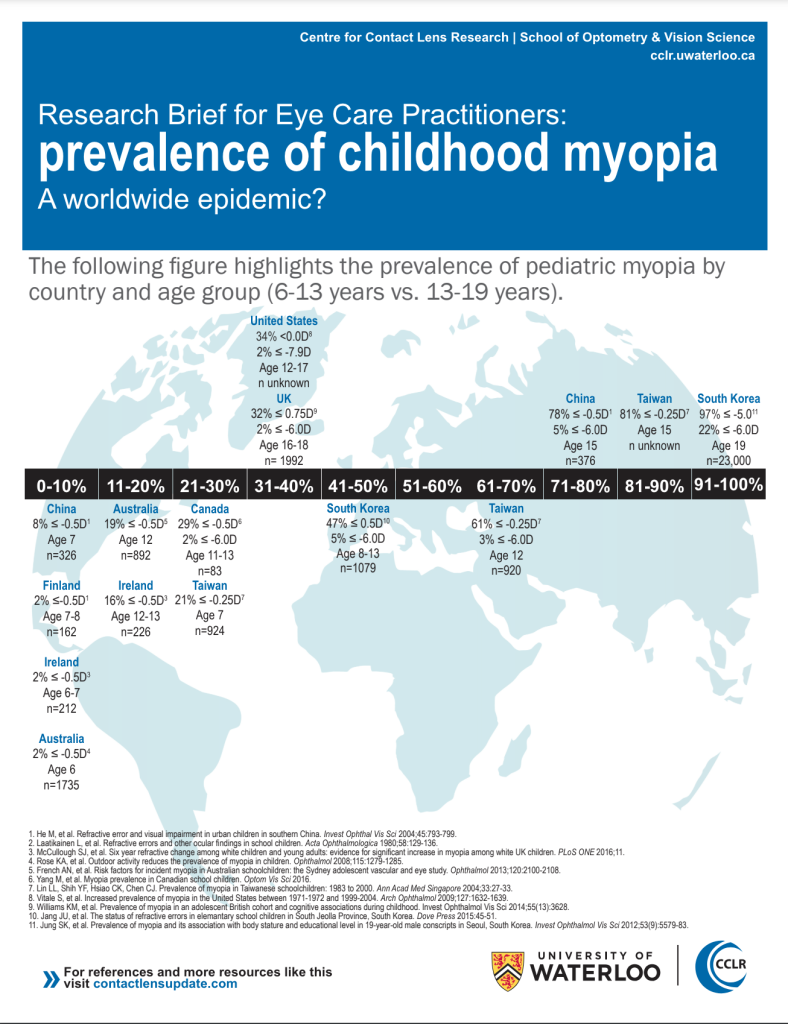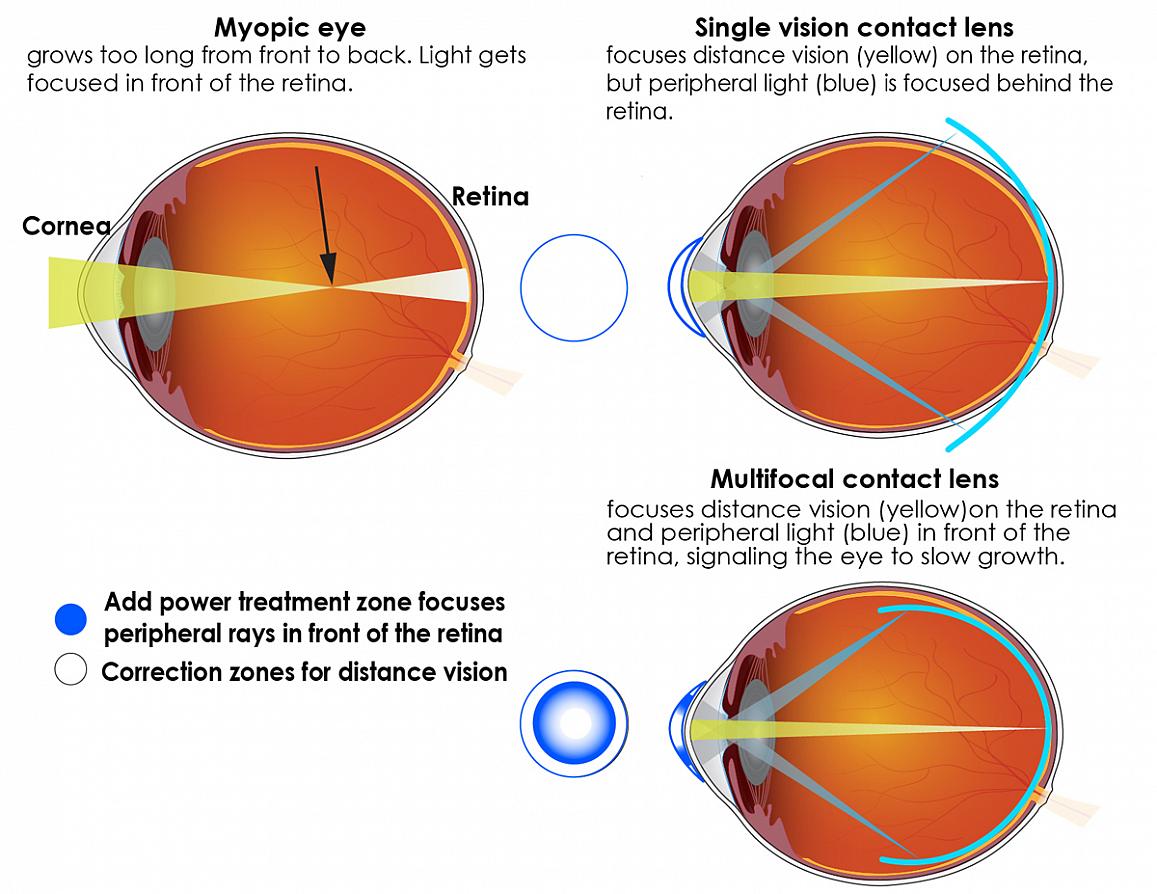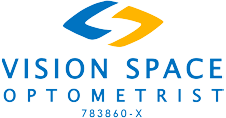Introduction
Myopia, commonly known as nearsightedness, has emerged as a significant public health concern globally, particularly in children. The increasing prevalence of myopia and its potential to lead to more severe ocular complications necessitates effective management strategies. Among the various interventions explored, multifocal soft contact lenses (MFCLs) have shown promise as a novel approach to slowing the progression of myopia in children. This blog aims to delve into the growing concern of myopia in children, introduce MFCLs as an innovative solution, and discuss how these lenses are transforming the management of childhood myopia based on the latest clinical human studies and scientific evidence.
Growing Concern of Myopia in Children
Myopia’s prevalence has been on a steady rise, with projections suggesting that nearly half of the world’s population might be affected by 2050 [5]. This increase is not just a matter of needing corrective lenses; high levels of myopia are associated with a greater risk of developing sight-threatening conditions such as retinal detachment, glaucoma, and myopic maculopathy [4][5].

The early onset of myopia in children is particularly concerning as it allows more time for the condition to progress to high myopia. Consequently, there is a pressing need for effective interventions to manage myopia from a young age to mitigate these risks [1][5].
Multifocal Soft Contact Lenses: A Groundbreaking Approach
Multifocal soft contact lenses have emerged as a groundbreaking approach to managing myopia progression in children. Unlike traditional single-vision lenses, MFCLs are designed with multiple prescription zones to correct nearsightedness while also addressing the defocus that contributes to myopia progression [2][3][4]. Clinical trials, such as the one conducted among Taiwanese schoolchildren, have demonstrated the efficacy of MFCLs in reducing the rate of myopia progression [2]. Following this, a study published in Investigative Ophthalmology & Visual Science (Invest Ophthalmol Vis Sci) further validated the efficacy of multifocal lenses in controlling myopia progression. These lenses represent a significant advancement in myopia management, offering a non-invasive, practical solution that can be easily integrated into a child’s daily life [2][3][4].
Revolutionizing the Management of Childhood Myopia
The introduction of MFCLs is revolutionizing the management of childhood myopia by providing an effective tool to slow its progression. Studies have shown that wearing MFCLs can significantly slow down the elongation of the axial length and the progression of myopia compared to traditional single-vision lenses [2][3][4][6]. This effect is crucial in preventing the development of high myopia and its associated complications. Furthermore, the combination of MFCLs with other interventions, such as low-dose atropine eye drops, has been explored, although MFCLs alone have shown substantial efficacy in controlling myopia progression [4]. The adoption of MFCLs in clinical practice reflects a shift towards proactive, preventive strategies in managing childhood myopia, emphasizing the importance of early intervention [1][2][3][4][6].
In conclusion, the growing concern of myopia in children and the quest for effective management solutions have led to the development and adoption of multifocal soft contact lenses. These lenses represent a significant advancement in the field, offering a practical and effective means of slowing myopia progression in children. As research continues to evolve, MFCLs stand at the forefront of innovative strategies, revolutionizing the approach to managing childhood myopia and potentially altering the trajectory of this global public health issue.
References:
- [1] Korziti, Samya et al. “Myopia management attitudes in children in clinical practice, towards an innovative and environmental study in Morocco.” E3S Web of Conferences (2023): n. Pag. (https://www.semanticscholar.org/paper/cd836cb557084b207878d95cba78643939844f85)
- [2] Liu, Yao-Lin et al. “Efficacy of Multifocal Soft Contact Lenses in Reducing Myopia Progression Among Taiwanese Schoolchildren: A Randomized Paired-Eye Clinical Trial.” Ophthalmology and therapy vol. 13,2 (2024): 541-552. doi:10.1007/s40123-023-00859-x (https://www.ncbi.nlm.nih.gov/pmc/articles/PMC10787710/)
- [3] Song, Desheng et al. “Efficacy and adverse reactions of peripheral add multifocal soft contact lenses in childhood myopia: a meta-analysis.” BMC ophthalmology vol. 24,1 173. 16 Apr. 2024, doi:10.1186/s12886-024-03408-7 (https://www.ncbi.nlm.nih.gov/pmc/articles/PMC11020872/)
- [4] Jones, Jenny Huang et al. “Effect of Combining 0.01% Atropine with Soft Multifocal Contact Lenses on Myopia Progression in Children.” Optometry and vision science : official publication of the American Academy of Optometry vol. 99,5 (2022): 434-442. doi:10.1097/OPX.0000000000001884 (https://pubmed.ncbi.nlm.nih.gov/35511120/)
- [5] Logan, Nicola et al. “Myopia: mechanisms, manifestations and management.” Ophthalmic & physiological optics : the journal of the British College of Ophthalmic Opticians (Optometrists) vol. 38,3 (2018): 207-209. doi:10.1111/opo.12461 (https://pubmed.ncbi.nlm.nih.gov/29691924/)
- [6] Peng, Tianli, and Jun Jiang. “Efficiency and Related Factors of Multifocal Soft Contact Lenses in Controlling Myopia.” Eye & contact lens vol. 49,12 (2023): 535-541. doi:10.1097/ICL.0000000000001043 (https://pubmed.ncbi.nlm.nih.gov/37990441/)
The Rising Tide of Childhood Myopia
Increasing Rates of Myopia Among Children Globally
Recent studies have highlighted a significant rise in the prevalence of myopia among children worldwide. A systematic review and quantitative meta-analysis, which included 143 published articles from 42 countries, found that the increase in myopia prevalence with age varied by ethnicity, with East Asians showing the highest prevalence. At 15 years of age, the prevalence reached 69% among East Asians, with a notable 86% among Singaporean-Chinese. In contrast, Blacks in Africa had the lowest prevalence at 5.5% at 15 years.
Over the past ten years, trends in myopia prevalence have indicated a slight rise among white populations, a 23% increase in East Asians, and a more modest increase in South Asians. Urban environments were found to significantly increase the odds of myopia compared with rural environments, and sex differences emerged around 9 years of age, with girls being twice as likely as boys to be myopic by late adolescence [7].
Another study aimed at assessing the risk factors affecting myopia in children found that girls were more likely to develop myopia, and children whose parents had myopia were also at a higher risk. Factors such as longer outdoor activities time will significantly decrease the incidence of myopia, while less near-work time appears to have a protective effect [10].
Long-term Risks Associated with Untreated or Rapidly Progressing Myopia
Untreated or rapidly progressing myopia in children can lead to several long-term risks and complications. A study on the natural progression of lamellar macular holes in high myopia over a long-term follow-up found a gradual decline in visual acuity, with significant deterioration from 36 months onwards. This study highlights the risk of structural and functional deterioration in highly myopic eyes, including the development of full-thickness macular holes and foveal detachment [9].
Furthermore, the global prevalence of myopia is increasing rapidly, and with it, the clinical and socioeconomic impacts are expected to rise. The lack of standardized guidelines for myopia management underscores the importance of focusing on preventing the incidence and progression of myopia. A national consensus on the prevention and management of childhood progressive myopia emphasizes the need for a comprehensive approach, including definition of myopia, refraction techniques, initiation of anti-myopia treatment, and follow-up schedules [9].
In summary, the increasing rates of myopia among children globally and the long-term risks associated with untreated or rapidly progressing myopia underscore the need for early detection, preventive measures, and effective management strategies to mitigate the potential for severe visual impairment and other complications.
Clinical References:
- [7] Rudnicka, Alicja R et al. “Global variations and time trends in the prevalence of childhood myopia, a systematic review and quantitative meta-analysis: implications for aetiology and early prevention.” The British journal of ophthalmology vol. 100,7 (2016): 882-890. doi:10.1136/bjophthalmol-2015-307724 (https://www.ncbi.nlm.nih.gov/pmc/articles/PMC4941141/)
- [8] Saxena, Rohit et al. “Prevention and management of childhood progressive myopia: National consensus guidelines.” Indian journal of ophthalmology vol. 71,7 (2023): 2873-2881. doi:10.4103/IJO.IJO_387_23 (https://www.ncbi.nlm.nih.gov/pmc/articles/PMC10491088/)
- [9] Ho, Mary et al. “Natural progression of lamellar macular holes in high myopia: a long-term follow-up study.” (2021). (https://www.semanticscholar.org/paper/b5cf3e45725052463fbf4c87b42ecf9f48078cd4)
- [10] Yu, Mingkun et al. “Global risk factor analysis of myopia onset in children: A systematic review and meta-analysis.” PloS one vol. 18,9 e0291470. 20 Sep. 2023, doi:10.1371/journal.pone.0291470 (https://www.ncbi.nlm.nih.gov/pmc/articles/PMC10511087/)
Understanding Multifocal Soft Contact Lenses
Explanation of Multifocal Soft Contact Lenses and Their Differences from Standard Contact Lenses
Multifocal soft contact lenses (MFCLs) are advanced optical devices designed to correct refractive errors across multiple distances, unlike standard single-vision soft contact lenses (SVCLs) that correct vision at one distance only. In adults, MFCLs are particularly beneficial for individuals who have both presbyopia and either myopia (shortsightedness) or hyperopia (farsightedness), providing them with the ability to see clearly at both near and far distances without the need for additional corrective glasses [11][12].

The primary difference between MFCLs and SVCLs lies in their lens design. SVCLs have a uniform optical power across the entire lens, which is suitable for correcting vision at a single distance. In contrast, MFCLs incorporate multiple lens powers or zones within a single lens. These zones are designed to correct vision at different distances, from near to intermediate to far [11][12]. This multifocal design is achieved through either a concentric ring pattern, where different zones alternate between near and distance corrections, or a progressive design, which gradually changes optical power from the center to the periphery of the lens [11][12].
Overview of the Design and Technology Behind MFCLs Aimed at Myopia Control
The design and technology of MFCLs aimed at controlling myopia (nearsightedness) involve specific features that address the progression of myopia in children and adolescents. These lenses are designed to create a form of optical defocus that extends beyond the retina, which is theorized to signal the eye to slow down in its growth, thus controlling myopia progression [11][12][13].
One common design feature in MFCLs for myopia control is the use of a center-distance design. This design places the distance correction at the center of the lens and the near correction in concentric rings around the center or in a progressive manner towards the periphery. This setup is intended to provide clear vision while simultaneously imposing a myopic defocus in the peripheral retina, which is believed to be effective in slowing the elongation of the eyeball that characterizes progressive myopia [11][12][13].
Technologically, these lenses often utilize high oxygen-permeable materials to ensure eye health and comfort, given that they are typically prescribed for continuous wear by young wearers. The materials and the precise control of optical properties across the lens surface are critical to ensure that the myopia control effect is consistent and effective [11][12].
In summary, multifocal soft contact lenses differ from standard contact lenses in their ability to correct vision at multiple distances through a segmented or gradient lens design. Their use in myopia control is supported by designs that specifically target the peripheral defocus to influence eye growth, utilizing advanced materials and optical engineering to achieve the desired therapeutic outcomes [11][12][13].
Clinical References:
- [11] Peng, Tianli, and Jun Jiang. “Efficiency and Related Factors of Multifocal Soft Contact Lenses in Controlling Myopia.” Eye & contact lens vol. 49,12 (2023): 535-541. doi:10.1097/ICL.0000000000001043 (https://pubmed.ncbi.nlm.nih.gov/37990441/)
- [12] Raffa, Lina H et al. “Myopia control with soft multifocal contact lenses: 18-month follow-up.” Saudi journal of ophthalmology : official journal of the Saudi Ophthalmological Society vol. 35,4 325-331. 13 Jun. 2022, doi:10.4103/1319-4534.347305 (https://www.ncbi.nlm.nih.gov/pmc/articles/PMC9266467/)
- [13] Ritchey, Eric R et al. “Intraocular Straylight and Multifocal Soft Contact Lens Fit With a Myopia Control Approach.” Eye & contact lens vol. 50,4 (2024): 171-176. doi:10.1097/ICL.0000000000001069 (https://pubmed.ncbi.nlm.nih.gov/38345090/)
The Science Behind the Solution
Concept of Peripheral Defocus and Eye Growth Regulation
Peripheral defocus refers to the way light focuses on the peripheral parts of the retina, as opposed to the central retina. In the context of myopia control, the concept of peripheral defocus is crucial because it influences how the eye grows longitudinally. Traditional single-vision lenses correct central vision by focusing light directly on the central retina, but they can inadvertently cause hyperopic defocus in the periphery, where light focuses behind the retina. This peripheral hyperopic defocus is believed to stimulate axial elongation of the eye, thus worsening myopia [14][17][18].
Multifocal lenses are designed to address this issue by providing different lens powers across the lens surface. The central zone corrects for distance vision (myopia), while the peripheral zones are designed to create myopic defocus, where light focuses in front of the peripheral retina. This myopic defocus is thought to send a stop signal to the eye, inhibiting further elongation of the eyeball and thus controlling myopia progression [14][17][18].
Mechanism of Action: Preventing Eyeball Elongation
The primary mechanism through which multifocal lenses control myopia is by preventing the elongation of the eyeball. By imposing myopic defocus in the peripheral retina, these lenses alter the traditional signaling pathways that regulate eye growth. Normally, hyperopic defocus (light focusing behind the retina) in the periphery would signal the eye to grow longer, exacerbating myopia. However, the myopic defocus induced by multifocal lenses counters this signal, potentially stabilizing or reducing the axial elongation that characterizes progressive myopia [14][17][18].
This mechanism is supported by the understanding that the eye’s growth is modulated by where and how light is focused within the eye. By ensuring that the peripheral defocus is myopic rather than hyperopic, multifocal lenses can effectively change the growth trajectory of the eye towards stabilization [14][17][18].
Effectiveness of Multifocal Lenses in Clinical Studies
Recent clinical studies have provided significant insights into the effectiveness of multifocal lenses for myopia control in children. The BLINK study, for instance, found that children wearing +2.50 D addition multifocal contact lenses showed slower axial growth compared to those wearing single vision lenses. This study highlighted that the type of lens (multifocal vs. single vision) played a more significant role in controlling eye growth than peripheral defocus alone [14].
Another study emphasized that while multifocal lenses do not significantly change choroidal thickness (a potential biomarker for myopia progression), they effectively reduce the progression of myopia by imposing myopic defocus [20]. Additionally, systematic reviews and meta-analyses have consistently shown that multifocal lenses can reduce the progression of myopia in children by about 50% compared to traditional single-vision lenses [15][16][19].
These findings underscore the potential of multifocal lenses as a viable optical intervention for managing myopia in children, with the dual benefits of correcting refractive error and controlling axial elongation, thereby mitigating the progression of myopia over time [14][15][16][19].
References:
- [14] Berntsen, David A et al. “Peripheral Defocus, Pupil Size, and Axial Eye Growth in Children Wearing Soft Multifocal Contact Lenses in the BLINK Study.” Investigative ophthalmology & visual science vol. 64,14 (2023): 3. doi:10.1167/iovs.64.14.3 (https://www.ncbi.nlm.nih.gov/pmc/articles/PMC10627291/)
- [15] Ewa, Grudzińska et al. “Methods of preventing and retarding the progression of myopia.” (2019). (https://www.semanticscholar.org/paper/a5423bc91cc4d8dd7b8e4490f5a5575bbdb90069)
- [16] Akinbinu, Tope R. et al. “Myopia control in the 21st century: A review of optical methods (2000–2019).” African Vision and Eye Health 79 (2020): 9. (https://www.semanticscholar.org/paper/3f8ce125ef8d4472af11a35c5d788601971a86cf)
- [17] Beasley, Ian G et al. “Effect of peripheral defocus on axial growth and modulation of refractive error in children with anisohyperopia.” Ophthalmic & physiological optics : the journal of the British College of Ophthalmic Opticians (Optometrists) vol. 43,4 (2023): 805-814. doi:10.1111/opo.13139 (https://pubmed.ncbi.nlm.nih.gov/37026593/)
- [18] Russo, Andrea et al. “Myopia: Mechanisms and Strategies to Slow Down Its Progression.” Journal of ophthalmology vol. 2022 1004977. 14 Jun. 2022, doi:10.1155/2022/1004977 (https://www.ncbi.nlm.nih.gov/pmc/articles/PMC9213207/)
- [19] Sankaridurg, Padmaja. “Contact lenses to slow progression of myopia.” Clinical & experimental optometry vol. 100,5 (2017): 432-437. doi:10.1111/cxo.12584 (https://pubmed.ncbi.nlm.nih.gov/28752898/)
- [20] Breher, Katharina et al. “The effect of the optical design of multifocal contact lenses on choroidal thickness.” PloS one vol. 13,11 e0207637. 16 Nov. 2018, doi:10.1371/journal.pone.0207637 (https://www.ncbi.nlm.nih.gov/pmc/articles/PMC6239323/)
Benefits Beyond Myopia Control
Improved Visual Acuity for Near and Distance
Multifocal soft contact lenses (MFCLs) are designed to correct vision at multiple distances by incorporating different lens powers within the same lens. Recent studies have shown that these lenses can effectively maintain or even improve visual acuity in both near and distance vision for myopic children. For instance, a study demonstrated that children fitted with high-add MFCLs achieved visual acuity comparable to that with spectacles, suggesting that these lenses do not compromise visual clarity while providing the added benefit of myopia control [22]. Another study highlighted that while high-add MFCLs might slightly reduce low-contrast distance visual acuity, they still maintain acceptable levels of high-contrast visual acuity [23]. These findings indicate that MFCLs can be a viable option for managing myopia while ensuring functional vision at various distances.
Increased Comfort and Ease of Use
Multifocal lenses are often preferred for their comfort and ease of use, which are crucial factors in achieving high compliance among pediatric users. The design of these lenses allows for a smooth transition between different focal points, which can reduce visual fatigue and discomfort associated with traditional bifocal or trifocal lenses. Studies have noted that children adapt well to these lenses, showing good tolerance and minimal complaints about discomfort [22][23]. This ease of use and comfort can lead to better adherence to wearing schedules prescribed by eye care professionals, which is vital for the effectiveness of myopia control strategies.
Potential to Reduce Dependency on Corrective Eyewear in the Future
The use of MFCLs in childhood could potentially reduce the dependency on corrective eyewear later in life. By controlling the progression of myopia at an early age, these lenses might limit the degree of myopia that needs correction in adulthood. Although direct evidence linking the use of MFCLs in children to reduced dependency on glasses or contact lenses later in life is still emerging, the principle of early intervention to moderate myopia progression suggests a promising outlook [21][22]. This approach aligns with the broader goals of myopia management, which include minimizing the long-term risks associated with high myopia, such as increased chances of developing serious ocular pathologies.
References:
- [21] Spors, Frank et al. “Visual Quality Indicators with Multifocal and Dual-Focus Soft Contact Lenses for Myopia Control.” Optometry & Contact Lenses (2023): n. Pag. (https://www.semanticscholar.org/paper/819d87f904634ca53192a1302bfa23e990e81a86)
- [22] Schulle, Krystal L et al. “Visual Acuity and Over-refraction in Myopic Children Fitted with Soft Multifocal Contact Lenses.” Optometry and vision science : official publication of the American Academy of Optometry vol. 95,4 (2018): 292-298. doi:10.1097/OPX.0000000000001207 (https://pubmed.ncbi.nlm.nih.gov/29561497/)
- [23] Bickle, Katherine M et al. “Visual Performance with Spherical and Multifocal Contact Lenses in a Pediatric Population.” Optometry and vision science : official publication of the American Academy of Optometry vol. 98,5 (2021): 483-489. doi:10.1097/OPX.0000000000001695 (https://pubmed.ncbi.nlm.nih.gov/33967252/)
Making the Switch: What Parents Need to Know
Guidance on When and How to Consider Multifocal Lenses for Your Child
Multifocal lenses, particularly soft multifocal contact lenses (SMCLs), are primarily considered for children to manage myopia progression. The decision to use these lenses should be based on several factors including the child’s age, the degree of myopia, and the rate of myopia progression. Clinical studies suggest that SMCLs are effective in slowing down myopia progression in children. For instance, children aged 7 to 11 years with myopia ranging from -0.75 to -5.00 diopters have been successfully fitted with +2.50 diopter addition multifocal contact lenses, which have shown to slow down the elongation of the eye [24][25][26]. Therefore, parents should consider multifocal lenses for their myopic children, particularly if they are within this age and myopia range.
The Process of Getting Your Child Fitted for Multifocal Soft Contact Lenses
The fitting process for multifocal soft contact lenses in children involves several steps. Initially, a comprehensive eye examination is necessary to determine the current level of myopia and to assess the overall eye health. Following this, specific measurements such as corneal curvature and pupil size are taken to select the appropriate lens type and fit [27]. Children are typically fitted with lenses like the Biofinity Multifocal “D” with a +2.50 D add, and an over-refraction is performed to fine-tune the vision correction [27]. It is crucial that these fittings are conducted by an eye care professional experienced in paediatric lenses to ensure optimal comfort and effectiveness in myopia control.
Tips on Helping Your Child Adjust to Wearing Multifocal Lenses
Adjusting to multifocal lenses can be challenging for some children, and parents can play a significant role in easing this transition. Here are some tips based on clinical studies and expert recommendations:
- Gradual Introduction: Start with short periods of wear and gradually increase as the child becomes more comfortable [27].
- Consistent Wear: Encourage regular use to help the child adapt more quickly to the sensation and vision differences with multifocal lenses [27].
- Monitoring and Feedback: Regularly check in with your child about their comfort and vision, and have follow-up visits with the eye care professional to adjust the fit or prescription as needed [27].
- Educational Support: Educate the child on the benefits of wearing these lenses, such as slowing myopia progression, which can motivate them to persist with the adjustment period [24][25].
By following these guidelines, parents can effectively support their children in transitioning to and benefiting from multifocal soft contact lenses.
References:
- [24] Berntsen, David A et al. “Peripheral Defocus, Pupil Size, and Axial Eye Growth in Children Wearing Soft Multifocal Contact Lenses in the BLINK Study.” Investigative ophthalmology & visual science vol. 64,14 (2023): 3. doi:10.1167/iovs.64.14.3 (https://www.ncbi.nlm.nih.gov/pmc/articles/PMC10627291/)
- [25] Jones, Jenny Huang et al. “Effect of Combining 0.01% Atropine with Soft Multifocal Contact Lenses on Myopia Progression in Children.” Optometry and vision science : official publication of the American Academy of Optometry vol. 99,5 (2022): 434-442. doi:10.1097/OPX.0000000000001884 (https://pubmed.ncbi.nlm.nih.gov/35511120/)
- [26] Chandler, Moriah A et al. “Accommodation in Children after 4.7 Years of Multifocal Contact Lens Wear in the BLINK Study Randomized Clinical Trial.” Optometry and vision science : official publication of the American Academy of Optometry vol. 100,7 (2023): 425-431. doi:10.1097/OPX.0000000000002040 (https://pubmed.ncbi.nlm.nih.gov/37369096/)
- [27] Schulle, Krystal L et al. “Visual Acuity and Over-refraction in Myopic Children Fitted with Soft Multifocal Contact Lenses.” Optometry and vision science : official publication of the American Academy of Optometry vol. 95,4 (2018): 292-298. doi:10.1097/OPX.0000000000001207 (https://pubmed.ncbi.nlm.nih.gov/29561497/)
Next Steps in Myopia Management for Your Child
Consultation with Pediatric Eye Care Specialists
The first step in managing a child’s myopia effectively involves encouraging parents to consult with an optometrist or ophthalmologist who specializes in pediatric eye care. This recommendation is based on the understanding that early and personalized assessments are crucial in determining the most appropriate interventions for myopia management. Specialists in pediatric eye care are equipped with the knowledge and tools to assess the specific needs of children, considering that myopia can progress differently in children compared to adults. These professionals can provide tailored advice and treatment options that may include myopia control prescription eyeglasses, myopia control soft contact lenses, or other therapeutic methods such as orthokeratology or atropine eye drops.
Importance of Regular Eye Exams and Monitoring
Regular eye examinations are vital for monitoring the progression of myopia in children. Scientific studies underscore the importance of ongoing monitoring to adjust treatment plans as needed and to prevent potential complications associated with high myopia, such as increased risks of developing serious ocular conditions later in life. Regular eye exams help in tracking changes in vision and the effectiveness of prescribed treatments, thereby enabling timely interventions. These exams should be conducted at intervals recommended by eye care professionals, which can vary depending on the child’s age, the severity of myopia, and the rate of progression observed.
These practices are supported by peer-reviewed clinical studies that highlight the effectiveness of early and regular interventions in managing myopia and preventing its severe consequences.
This Article is Medically Reviewed by Oh Poh Ling

Poh Ling graduated as an optometrist from SEGi University. She believes that a person will be able to fully enjoy life when they have comfortable vision and healthy eyes. Poh Ling is involved in numerous vision screenings for the underprivileged school children and also for the public in an aim to promote awareness about the importance of regular eye examination. She enjoys travelling and playing tennis.
Her Specialties includes:
1. Specialty contact lens fitting: Keratoconus
2. Orthokeratology
Favourite Quote: “While there’s life, there is hope.” – Stephen Hawking

